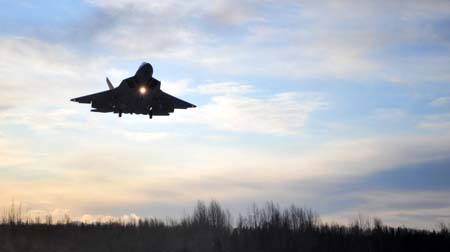In  the 2020s, the Air Force intends to be at full-rate production with its new tanker, next-generation bomber, the F-35 strike fighter, and a new advanced trainer aircraft, said Todd Harrison, a senior fellow for defense budget studies at the Center for Strategic and Budgetary Assessments. That’s a lofty order even without the Budget Control Act’s money-slashing sequestration clause going into effect, said Harrison during a briefing last week in Washington, D.C. “Bottom line, the Air Force is going to have a budget crunch one way or another. This was going to happen regardless of sequestration . . . so they are going to have to make some tough choices over the coming years,” he said. However, modern aircraft like the F-22 and F-35 are far more capable than their predecessors, he said. Remotely piloted aircraft also may be able to soften the budget blow, said Harrison. However, “we might need to shift our investment in the type of [RPAs] we’ve been buying” since “Predators and Reapers . . . are completely vulnerable” to enemy air defenses, he said. Instead, the Air Force should consider buying stealthy unmanned aircraft capable of operating in denied environments, said Harrison.
the 2020s, the Air Force intends to be at full-rate production with its new tanker, next-generation bomber, the F-35 strike fighter, and a new advanced trainer aircraft, said Todd Harrison, a senior fellow for defense budget studies at the Center for Strategic and Budgetary Assessments. That’s a lofty order even without the Budget Control Act’s money-slashing sequestration clause going into effect, said Harrison during a briefing last week in Washington, D.C. “Bottom line, the Air Force is going to have a budget crunch one way or another. This was going to happen regardless of sequestration . . . so they are going to have to make some tough choices over the coming years,” he said. However, modern aircraft like the F-22 and F-35 are far more capable than their predecessors, he said. Remotely piloted aircraft also may be able to soften the budget blow, said Harrison. However, “we might need to shift our investment in the type of [RPAs] we’ve been buying” since “Predators and Reapers . . . are completely vulnerable” to enemy air defenses, he said. Instead, the Air Force should consider buying stealthy unmanned aircraft capable of operating in denied environments, said Harrison.
F-35As from the Vermont Air National Guard have deployed to Puerto Rico in recent days, continuing a major buildup of U.S. Air Force assets in Latin America aimed at combating drug trafficking and pressuring the regime of Venezuelan leader Nicolas Maduro.

